A Patchwork of Hindu Ritual Practices and Technique Performances? A Re-Examination of the Citrakarmaśāstra, a Vajrayānic Sanskrit Śilpa Text Discovered in Sri Lanka
Abstract
1. Introduction
1.1. Discovery of the Sanskrit Manuscript in Sri Lanka
- (1)
- Types of Locale and Monasteries (sthānālayabheda)
- (2)
- Characteristics of the 24 Monasteries (caturviṃśārāmalakṣaṇa)
- (3)
- Characteristics of the Caitya (caityalakṣaṇa)
- (4)
- Types of Trees (vṛkṣasaṅgrahaḥ)1
- (5)
- Explanation of Dimensions (mānoddeśavidhānam)2
- (6)
- Arrangement of the Sanctuary of a Temple (garbhāgāravidhānam)
- (7)
- Characteristics of the Armature (śūlalakṣaṇa)
- (8)
- Installation of the Gem Deposit (ratnanyāsavidhāna)
- (9)
- Making of the Eight-fold Paste (aṣṭabandhavidhāna)
- (10)
- Placing of the Ligatures (rajjukarmavidhāna)
- (11)
- Characteristics of the Clay (mṛttikālakṣaṇa)
- (12)
- Making of the Limestone Paste (kaṭiśarkarāvidhāna)
- (13)
- Description of the Measurements (pramāṇalakṣaṇa)
- (14)
- Description of the Plumb-lines (lambamānalakṣaṇa)
- (15)
- Characteristics of the Five Buddhas and so on (pañcabuddhādilakṣaṇa)
- (16)
- Preparation of the Pigments (varṇalakṣaṇavidhāna)
- (17)
- Opening of the Eyes (akṣimokṣaṇa)
1.2. Background and Research Questions
2. Analysis of the Compilation of the Citrakarmaśāstra
2.1. The Sequence of Chapters in the Citrakarmaśāstra
2.2. On the Chapter of Selecting Trees and Rituals for Worshipping and Felling Trees
2.2.1. Content of the Text
2.2.2. Correspondence with Non-Buddhist Texts
2.3. On the Chapter of the Consecration Rituals of the Pedestal of an Image
2.3.1. The Ratnanyāsa-Maṇḍala
āryāṃśe mauktika[n] nyāsya[ṃ] puṣparāgaṃ vivasvake,mitre padmarāgaṃ syād bhūmīndre marakataṃ nyaset,ajāṃśe vajraṃ vinyasyan tasyaiva dhātu nikṣipet.
pañcabuddhātmakaṃ rūpañcaturdigmadhye nikṣipet.
sāvitrāṃśe tu vaiḍūryaṃ hemamākhaṇḍale nyaset,rudraje [ca] pravālantu āpavatsāṃśe nīlakam.
caturdevyātmakaṃ rūpañcatuṣkoṇeṣu vinyaset.
jayante jātihiṅgulyaṃ bhṛśe tu haritā[la]kam.vitathe manaḥśilā proktā bhṛṅgarāje tu mākṣikam,sukaṇṭhe rājāvartaṃ syāt śoṣāṃśe gairikambhavet,mukhye añjanaṃ vidhātavya ditauttaram bhavet.10
īśe vaikṛ{ta}ntakaṃ sthāpyantrapusagnipade nyaset.
sīsantu pitṛmāge (pitṛbhāge?) tu phaṇāntaṃ mārutāṃśake.
āditye rajataṃ vajraṃ yamāṃśe khaṅgamāyasam.varuṇe ratna[n] tāmraṃ syāt so[ma] padāntaraṃ puṣpakam,sauvarṇañcakramadhye tu sthāpayet pañcacihnake.
2.3.2. The Rituals for Performing the Ratnanyāsa
2.3.3. Correspondence with Śaiva Texts
devamānuṣabhāgābhyāṃ sthāpyā yatnāttu piṇḍikā,
napuṃsakaśilāyāntu ratnanyāsaṃ samācaret.
nārasiṃhena hutvā ratnanyāsaṃ ca tena vai,
vrīhīn ratnāṃstridhātūṃś ca lohādīṃś candanādikān.
pūrvādinavagarteṣu nyasen madhye yathāruci,
atha cendrādimantraiś ca garto guggulunāvṛtaḥ
(Agnipurāṇa 60. 3–5)
- (1)
- Preparation of a compartmentalized casket/reliquary made of gold, silver, or copper, with 25 or 9 compartments; the division into twenty-five compartments agrees with the upapīṭha diagram of the site plan, while that of nine compartments agrees with the pīṭha diagram.
- (2)
- Construction and purification of a temporary pavilion.
- (3)
- Decoration of the pavilion for the ritual with canopies, flags, and banners, and beautified with darbha grass.
- (4)
- Consecration objects, including gems, minerals, grains, flowers, perfumes, etc.
- (5)
- Fire oblation.
2.3.4. Archaeological Evidence Correspondent with Texts
2.4. On the Chapters of the Techniques of Clay Modeling
2.4.1. Content of the Text
- (1)
- The wooden armatures (śūla) are crafted in varying measurements, each tailored to the intended figure’s system of measurement.
- (2)
- After the armatures are made, a paste or glue made from eight ingredients (aṣṭabandha) should be applied over the whole body of the armature (sarvāṅgalepana). These eight ingredients are prepared in proportion: red mineral (dhāturāga), lac (lākṣā), ikṣura15, gum-resin of the Indian bdellium tree (gugguli), bel resin (bilvaniryāsa), wood-apple resin (kapitthaniryāsa), rasa-resin (rasaniryāsa)16, and coconut water (nālikerajala). However, the section dealing with the preparation of the paste is missing from the manuscript. This paste is applied to provide the image with channels, veins, ligaments, and arteries.
- (3)
- Ligatures are attached to the wooden armature, representing the major and subsidiary subtle channels (nāḍis and nāḍikas), veins (sīras), ligaments (snāyus), arteries (dhamanis), and navel cakra (nābhicakra). The central channel, the suśumnā, is coiled like a sleeping serpent along the central pole (bhujaṅgaḥ śayita iva{bhyā}suṣumnā śūlamāvṛt[t]am), while the iḍā and piṅgalā are applied to the right and left sides, respectively. These three major nāḍis meet at the meeting place of the eyebrows and give rise to seven nāḍikas: gāndhārī, hastijihvā, pūṣā, [yaś]asvinī, alambuṣā, kuhū, and śaṅkhinī. The veins, ligaments, and arteries are twenty-four in number. Details on the sīras and snāyus are lacking in the text, and only the section about the dhamanis is clear. Of the twenty-four dhamanis, ten originate from the head. The remaining ten firmly bind the thighs, legs, and the navel, while the last four run horizontally and are referred to as the lower dhamanis (caturviṃśaddhamanyaśca daśa mūrdhodayaṃ viduḥ, ūrūjaṅghāṃ tathā nābhiṃdaśena vadhnīyātsthiram, tiryaggāśca caturbhedādho dhamanyo vidhīyate) (Marasinghe 1991, pp. 62–65). The section regarding the navel cakras remains unclear.17
- (4)
- The next stage is the preparation of the clay (mṛttikā) that covers the armature. Clay collection should be performed in the forenoon during the śatabhiṣaj star conjunction, near a lake, mountain, or holy site (vāpīkūpataṭākānāṃ dīrghikānāṃ [ca] saṅgame, parvate puṇyadeśe vā pūrvāhne [śa]tayogataḥ). The clay should be perfumed and heated, with additional ingredients such as gold, silver, copper, three sweets (trimadhuka), three spices (kaṭuka), pūtanāśī, fragrant powder (vāsayoga), yellow orpiment (haritāla), three fruits (triphala), resin, sarja tree, vājimūla, and coconut water mixed in. The text then mentions the creation of three clay varieties but does not clarify what these are. Having decorated every abhra (?), the master artisan should accordingly perfume three varieties of clay for a month (trividhaṃ mṛttikālepyaṃ yatamānena kalpitam. ekaikamabhraṃ saṃskṛtya guruśilpī vidhānataḥ, trividhaṃ mṛttikālepyaṃ māsaikaṃ vāsayet kramād).
- (5)
- Then limestone paste (kaṭaśarkarā), in three varieties based on gender (male, female, neuter), is added. The process for determining the gender of the powder is not specified. The limestone powder is mixed with kapittha juice and extracts from three fruits, then fumigated for three to four months. The subsequent steps are less clear.
- (6)
- A new white cloth for covering the image should be made. The artisan should perform the adhivāsana ritual, offer oblations to the vāstudevas, and then gradually cover the image with the cloth (paṭamācchādana).
- (7)
- Then follows the preparation of pigments (varṇa) and coloring of the image. The text briefly mentions the six primary colors by citing various objects representative of each color but does not provide further instructions for preparing them. It speaks of six types of skin (chavi) painting: the hue of the lotus (padmaka), light color (gauraka), bindu, dark color (dhūmraka), vartana, and pravartana, with the last three remaining unexplained. Before applying the appropriate colors, a white coating is used, followed by a yellowish-white coating; lastly, lines or figures are drawn that resemble the colors.(prathamaṃ śvetavarṇañca dvitīyaṃ pāṇḍaracchaviḥ. tṛtīyaṃ varṇasaṃkāśam patrakādīnimiṣyate).18
śūlas correspond to bones (asthis),aṣṭabandha is associated with fat (medas),rajjus are compared to veins (sirās),mṛttikā symbolizes flesh (māṃsa),kaṭaśarkarā represents blood (śoṇita/rudhira),paṭa is metaphorically linked to skin (tvak/tvaca), andvarṇa is seen as the embodiment of life (jīva).
2.4.2. Correspondence with Hindu Śilpa-śāstras and Present-Day Performances of Hindu Image Making
2.5. On the Chapter of the Eye-Opening Ceremony
2.5.1. Content of the Text
2.5.2. Correspondence with the Other Sanskrit Buddhist and Hindu Śilpa Texts
- (1)
- Commencing with the sowing of seeds.
- (2)
- Constructing and purifying a temporary pavilion.
- (3)
- Decorating the pavilion with canopies, flags, banners, and embellishments using darbha grass.
- (4)
- Applying either the pīṭha maṇḍala or the upapīṭha maṇḍala.
- (5)
- Performing the placing of pots (kalaśādhivāsana) after opening the eyes.
2.5.3. Partial Correspondence with the Buddhist Ritual Practice in Sri Lanka
提此大圓鏡,光明遍十方。圓光普照於十方,咸令眾生增福慧。光光體本同,鏡光映慈光。光照遍十方,妙用無障礙。
3. Conclusions
- (1)
- The Citrakarmaśāstra was likely intended for ritual specialists and artisans who already possessed a good understanding of the practices described in the text.
- (2)
- The Citrakarmaśāstra appears to serve as a rough outline or reference guide rather than a comprehensive and detailed explanation of the practices and performances. It may have assumed that practitioners were already familiar with the basics.
- (3)
- The Citrakarmaśāstra can be seen as a Buddhist attempt to emulate Brahmanical śilpa literature, as well as a compilation of an idealized knowledge system. This idealized system might not perfectly correspond with actual practices and performances, which could explain the absence of crucial information and the use of simplified Sanskrit within the text.
Funding
Data Availability Statement
Acknowledgments
Conflicts of Interest
| Abbreviations | |
| Pā. | Pāli |
| Sinh. | Sinhalese |
| Skt. | Sanskrit |
| Symbols used in the Transliteration and Translation | |
| {} | superfluous akṣara(s) |
| [] | omitted (part of) akṣara(s) and word(s) |
| [+ + +] | corrupt sections in the manuscript, with no suggestions offered by the editor or the author |
| ‘ | avagraha (not written in the manuscript, but added in the transliteration) |
| 1 | Marasinghe splits the fourth chapter into two separate chapters, which become chapters four and five of his edition. Because he splits this chapter into two, he also emends each of the subsequent chapter colophons to accommodate this change (i.e., there are 18 chapters in his edition). Powell does not agree with his change and follows the original colophons for the subsequent chapters, giving seventeen rather than eighteen chapters. I agree with Powell; see Powell (2018, p. 95). |
| 2 | According to the manuscript, the concluding sentence at the end of this chapter is “vṛkṣasaredavidhāno pañcamo ‘dhyāyaḥ.” Based on the contents of this chapter, Marasinghe reconstructs the title of this chapter as “mānoddeśavidhānam.” I follow his suggestion; see Marasinghe (1991, p. 18). Powell also agrees with Marasinghe; see Powell (2018, p. 95). |
| 3 | The two volumes covering the two subjects separately are, therefore, published under the two titles Vāstuvidyāśāstra and Citrakarmaśāstra respectively; see Marasinghe (1991, p. xi). |
| 4 | |
| 5 | Regarding the studies on the Śāriputra-bimbamāna, see Coomaraswamy (1908, pp. 150–63), Ruelius (1974), and Marasinghe (1994). Regarding the research on the Ālekhyalakṣaṇa, see Ruelius (1974). |
| 6 | Marasinghe (1991, pp. 8–9). The translation of passages from the Citrakarmaśāstra is based on Marasinghe’s translation, with some modifications and explanatory notes added by the author. The same approach is followed throughout the article. |
| 7 | |
| 8 | Shastri and Bhat (1946, pp. 518–21). The Sanskrit text reads: paramānnamodakaudanadadhipalalollopikādibhir bhakṣyaiḥ madyaiḥ kusumair dhūpair gandhaiśca taruṃ samabhyarcya. surapitṛpiśācarākṣasabhujagāsuragaṇavināyakādyānām, kṛtvā rātrau pūjāṃ vṛkṣaṃ saṃspṛśya ca brūyāt. arcārthamamukasya tvaṃ devasya parikalpitaḥ, namaste vṛkṣa pūjeyaṃ vidhivat sampragṛhyatām. yānīha bhūtāni vasanti tāni baliṃ gṛhītvā vidhivat prayuktam, anyatra vāsaṃ parikalpayantu kṣamantu tānyadya namo ‘stu tebhyaḥ. |
| 9 | It is interesting to note that the names of the four śaktis (i.e., Tārā, Locanā, Prajñā, and Māmukhī) here are slightly different from the regular four consorts (i.e., Tārā, Locanā, Pāṇḍarā, Māmakī) in the vajradhātu maṇḍala in Buddhism in North India and Nepal as well as China’s Xizang. The text reads catuṣkoṇe catuśakti[r] īśānādipratiṣṭhā, literally meaning “the four śaktis are placed at four corners beginning with Īśāna (i.e., Īśa)”. Marasinghe interpreted “Īśāna” as the quadrant of Īśa; see Marasinghe (1989, p. 185). According to Powell, “Īśa” here refers to the northeast, rather than to the quadrant of Īśa. Otherwise, the four śaktis would be placed on the periphery of the maṇḍala, at quite a distance form their male counterparts, which is possible but unlikely; see Powell (2018, p. 48). I agree with Powell’s suggestion. |
| 10 | The manuscript reads “mukhye añjanaṃ vidhātavya ditauttaram bhavet”, but E.W.Marasinghe reads “mukhye añjanaṃ vidhātavya[n] ditāvantaritam bhavet”. He proposes “antaritam” to be red lead; see Marasinghe (1991, pp. 50–51). |
| 11 | The manuscript reads “pañcacihnake”, while Marasinghe emends it to “pañcacihnakam”. Marasinghe’s translation states: gold as well as the five symbols should be deposited in the center of the diagram; see Marasinghe (1991, pp. 52–53). I follow the reading in the manuscript and interpret “pañcacihnake” as a bahuvrīhi compound (one having five symbols), describing “cakramadhye”. |
| 12 | Marasinghe (1991, pp. 54–55). The deities here are clear, though not mentioned by name. The only deities that might be missing are the four female consorts. |
| 13 | |
| 14 | Similar stone deposit boxes have also been discovered in Hindu and Buddhist ruins in Java; see Deraniyagala (1978). |
| 15 | In the manuscript, this ingredient is first referred to as “pusāraka” and later “ikṣara”. Marasinghe emends the latter to “pusāraka”, aligning it with the first enumeration; see Marasinghe (1991, p. 60). Powell suggests the reading “ikṣura”, which likely refers to the Saccharum Spontaneum, a common grass in the Indian subcontinent and Sri Lanka; see Powell (2018, p. 97). I concur with Powell’s interpretation. |
| 16 | The manuscript reads “rataniryāsa”, while Marasinghe emends it to “rasaniryāsa”; see Marasinghe (1991, p. 60). Powell suggests the reading “ratnaniryāsa”; see Powell (2018, p. 97). I agree with Marasinghe. |
| 17 | The manuscript reads: “nābhicakradamāśṭho ca sarveṣārmāstabandhanam”, which Marasinghe emends to read: “nābhicakraṃ daśāśṭañca sarveṣāmasthibandhanam.” Both readings are confusing; see Marasinghe (1991, pp. 64–65). |
| 18 | Marasinghe (1991, pp. 162–63). In the third step, Marasinghe literally translated the patraka into “leaf-design”. According to the revised and enlarged edition of Apte’s dictionary (p. 958), “patraka” also means drawing lines or figures on the body as a decoration. Chapter 16 is about the coloring of a clay image; thus, the latter meaning better reflects the context’s intended meaning. I take the latter one in my translation. For the link to the dictionary, see https://dsal.uchicago.edu/cgi-bin/app/apte_query.py?page=958 (date of access: 30 December 2023). |
| 19 | Regarding the date of the Vimānārcanākalpa, see Rao (1914, p. 56), Kramrisch (1946, p. 261), Banerjea (1956, p. 26), and Colas (2019). |
| 20 | |
| 21 | I have published a Chinese article conducting a textual comparative study of these chapters in the Citrakarmaśāstra and the śaiva texts. However, in my previous article, the vaikhāsana texts were not examined, and the study did not investigate the current practices in Hindu image making; see Wu (2021). In this part of my article, I build upon my previous research by including the vaikhāsana texts for comparison and focusing on the relationship between the texts and contemporary practices. |
| 22 | Vajhe (1926, p. 250); Ganapatisāstrī (1929, pp. 87–88). For a discussion of the eight-fold pastes in the śaiva texts, see Varma (1970, pp. 11–12). |
| 23 | Ganapatisāstrī (1929, p. 88). A similar method is also mentioned in the Kāśyapaśilpa; see Vajhe (1926, p. 250). |
| 24 | http://gretil.sub.uni-goettingen.de/gretil/1_sanskr/4_rellit/saiva/gorst1pu.htm (date of access: 1 October 2023). For an introduction to the Gorakṣaśataka, see Mallinson (2012). |
| 25 | For a full discussion of this section in both the Kāśyapaśilpa and the Śilparatna, see Varma (1970, pp. 16–18). |
| 26 | Colors in the Citrakarmaśāstra are associated with the three guṇas (i.e., sāttvika, rājasa, tāmasa), aligning with the definition of colors in the Sāṃkhya school of Hindu philosophy; see Marasinghe (1991, p. 160). Notably, this viewpoint is rejected by Buddhists, as evident in certain Chinese Buddhist texts from the Tang Dynasty. However, the author/compiler of the Citrakarmaśāstra embraces this perspective, revealing non-Buddhist influences on the text; see Wu (2021). |
| 27 | Vajhe (1926, p. 254), Ganapatisāstrī (1929, p. 93). For a discussion on their resemblances, see Wu (2021). |
| 28 | http://www.westmichiganhindutemple.org/wmhtevents-sep-pranaprathishta.htm (date of access: 1 October 2023). |
| 29 | Richard Clarke, “Culmination of Kumbabishekam of Gowthama Maharishi Temple in Tiruvannamalai”, https://richardarunachala.wordpress.com/2013/01/10/culmination-of-kumbabishekam-of-gowthama-maharishi-temple-in-tiruvannamalai/ (date of access: 1 October 2023). |
| 30 | |
| 31 | |
| 32 | For a full discussion on the use of the mirror in Buddhist image consecration rituals, see Swearer (2007, pp. 212–22). The use of a mirror is also a tradition preserved in Hindu image consecration rituals, with a symbolism different from that of Buddhism, although not mentioned in the aforementioned Hindu texts. According to Hindu mythology, the well-being of the world is believed to depend on the gaze of the deities. This is why the all-seeing gods are said never to close their eyes. Worshippers, in turn, must keep their eyes open to make reciprocal contact with the divine. The mirror, therefore, serves as a medium used in Hindu rituals and incorporated into religious images to help manufacture and propagate darśan: the sense of ritual connectedness with the divine through the gaze; see Babb (1981). |
| 33 | Marasinghe (1991, pp. 64–65). It is interesting to note that the total number of nāḍis is 27,000 in both the Kāśyapaśilpa and the Śilparatna. |
References
Primary Sources
- Bhatt, N. Ramachandra, ed. 1964. The Ajitāgama. Pondicherry: Institut Français D’Idologie, vol. I. [Google Scholar]
- Ganapatisāstrī, T., ed. 1929. Śilparatna of Srī Kumāra. Trivandrum: Government Press, vol. 2. [Google Scholar]
- Mitra, Rājendralāla, ed. 1873. Agnipurana: A Collection of Hindu Mythology and Traditions. Calcutta: Ganeśa Press, vol. 1. [Google Scholar]
- Prayāgadāsajī, Raghunāthacakravarti Bhaṭṭācārya, and Setu Mādhavācārya, eds. 1926. Śrīmadvaikhānase Śrīmaharṣimarīcipraṇītānandādi Saṃhitāmahāśāstre Śrī Vimānārcanākalpa. Madras: Śrī Veṅkaṭeśvara Mudraṇālaya. [Google Scholar]
- Śāstrī, K. Sambasiva, ed. 1935. Vaikhānasāgama. Trivandrum: Government Press. [Google Scholar]
- Vajhe, Kṛṣṇa Rāya, ed. 1926. Kāśyapaśilpa, Ānandārama Sanskrit Series 41. Poona: Ānandāramamudraṇālaya. [Google Scholar]
Secondary Sources
- Acharya, Prasanna Kumar. 2011. Architecture of Mānasāra, revised ed. Delhi: New Bharatiya Book Corporation, vol. 2. [Google Scholar]
- Babb, Lawrence A. 1981. Glancing: Visual Interaction in Hinduism. Journal of Anthropological Research 37: 387–401. [Google Scholar] [CrossRef]
- Banerjea, Jitendra Nath. 1956. The Development of Hindu Iconography, 2nd revised ed. Calcutta: University of Calcutta. [Google Scholar]
- Bentor, Yael. 1995. On the symbolism of the mirror in Indo-Tibetan consecration rituals. Journal of Indian Philosophy 23: 57–71. [Google Scholar] [CrossRef]
- Bentor, Yael. 1996. Consecration of Images and Stūpas in Indo-Tibetan Tantric Buddhism. Leiden: Brill. [Google Scholar]
- Colas, Gérard. 1984. Présentation et analyse de la Marīcisaṃhitā. Journal Asiatique 272: 344–68. [Google Scholar]
- Colas, Gérard. 2019. Icons, Troubled and Troubling: Some Observations from the Vimānārcanakalpa. Cracow Indological Studies XXI: 41–68. [Google Scholar]
- Coomaraswamy, Ananda K. 1908. Mediaeval Sinhalese Art. Broad Campden: Essex House Press. [Google Scholar]
- Dagens, Bruno, trans. 1970. Mayamata: Traité Sanskrit d’Architecture. Pondicherry: Institut Français d’Indologie. [Google Scholar]
- Dagens, Bruno. 1985. Mayamata: An Indian Treatise on Housing Architecture and Iconography. Delhi: Motilal Banarsidass Publishers. [Google Scholar]
- de Silva, Lily. 1978. The Symbolism of the Indrakīla in the Parittamaṇḍapa. In Senarat Paranavitana Commemoration Volume. Edited by Johanna Engelberta van Lohuizen-de Leeuw, Leelananda Prematilleke and Karthigesu Indrapala. Leiden: Brill, pp. 234–50. [Google Scholar]
- Deraniyagala, Paulus Edward Pieris. 1978. Some archaeological problems concerning Sri Lanka and its trade routes. In Senarat Paranavitana Commemoration Volume. Edited by Johanna Engelberta van Lohuizen-de Leeuw, Leelananda Prematilleke and Karthigesu Indrapala. Leiden: Brill, pp. 51–53. [Google Scholar]
- Gombrich, Richard. 1966. The Consecration of a Buddhist Image. The Journal of Asian Studies 26: 23–36. [Google Scholar] [CrossRef]
- Jacob, Jose. 2007. Opening the Eye: “Seeing” as “Knowing” in Vastusastra (Indian Architectural Theory) According to the Treatise Manasara. In Chora 5: Intervals in the Philosophy of Architecture. Edited by Alberto Pérez-Gómez and Stephen Parcell. Montreal: McGill-Queen’s University Press. [Google Scholar]
- Jayasuriya, Mahabaduge Hiranya Fernando, Leelananda Prematilleka, and Roland Silva. 1995. Mañjuśrī Vāstuvidyāśāstra: Romanized Transcript with a Tentative Edition, English Translation and Studies. Colombo: The Archaeological Survey of Sri Lanka and The Central Cultural Fund. [Google Scholar]
- Kramrisch, Stella. 1946. Hindu Temple. Calcutta: University of Calcutta, vol. I. [Google Scholar]
- Long, Mark. 2009. Caṇḍi Mendut: Womb of the Tathāgata. New Delhi: Aditya Prakashan. [Google Scholar]
- Losch, Hans. 1950. Sources of Srī Kumāra’s Śilparatna. Annals of the Bhandarkar Oriental Research Institute 31: 152–64. [Google Scholar]
- Mallinson, James. 2012. The Original Gorakṣaśataka. In Yoga in Practice. Edited by David Gordon White. Princeton: Princeton University Press, pp. 257–72. [Google Scholar]
- Marasinghe, Eugen W. 1989. The Vāstuvidyā Śāstra ascribed to Mañjuśrī. Delhi: Sri Satguru Publications. [Google Scholar]
- Marasinghe, Eugen W. 1991. Citrakarmaśāstra Ascribed to Mañjuśrī, Being Volume II of Vāstuvidyāśāstra, Edited with an Introduction and an English Translation. Delhi: Sri Satguru Publications. [Google Scholar]
- Marasinghe, Eugen W. 1994. The Bimbamāna of Gautamīyaśāstra: As heard by Śāriputra. Delhi: Sri Satguru Publications. [Google Scholar]
- Powell, Kellie Marie. 2018. Rituals and Ruins: Recovering the History of Vajrayāna Buddhism in Sri Lanka: A Thesis Submitted in Partial Satisfaction of the Requirements for the Degree of Master of Arts in South and Southeast Asian Studies. Master’s thesis, University of California, Berkeley, CA, USA. [Google Scholar]
- Rajeev, Sharat Sunder. 2016. The King’s Craftsmen: History of the Ivory Carvers of Thiruvananthapuram. Thiruvananthapuram: Kerala Council for Historical Research. [Google Scholar]
- Rao, T. A. Gopinatha. 1914. Elements of Hindu Iconography, Vol. I, Pt. 1. Madras: The Law Printing House. [Google Scholar]
- Ruelius, Hans. 1974. Śariputra und Ālekhyalakṣana: Zwei Texte Zur Proportionslehre in der Indischen und Ceylonesischen Kunst. Ph.D. dissertation, University of Göttingen, Göttingen, Germany. [Google Scholar]
- Ruelius, Hans. 1978a. Manjuśribhāṣita-Citrakarmaśāstra: A Mahayanistic Śilpa-śāstra from Sri Lanka. In Buddhism in Ceylon and Studies on Religious Syncretism in Buddhist Countries: Report on a Symposium in Göttingen. Edited by Heinz Bechert. Göttingen: Vandenhoeck & Ruprecht. [Google Scholar]
- Ruelius, Hans. 1978b. Netrapratiṣṭhāpana: Eine singhalesische Zeremonie zur Weihe von Kultbildern. In Buddhism in Ceylon and Studies on Religious Syncretism in Buddhist Countries: Report on a Symposium in Göttingen. Edited by Heinz Bechert. Göttingen: Vandenhoeck & Ruprecht. [Google Scholar]
- Shastri, J. L., G. P. Bhatt, and N. Gangadharan, trans. 1998. The Agni Purāṇa Part 1. Delhi: Motilal Banarsidass Publishers. First published 1954. [Google Scholar]
- Shastri, Panditabhushana V. Subrahmanya, and Vidwan M. Ramakrishna Bhat. 1946. Varahamihira’s Brhatsamhita. Bangalore: M.B.D Electric Printing. [Google Scholar]
- Ślączka, Anna A. 2007. Temple Consecrations Rituals in Ancient India: Text and Archaeology. Leiden: Brill. [Google Scholar]
- Ślączka, Anna A. 2017. The Ratnanyāsa Ritual in the Devyāmata. In Consecration Rituals in South Asia. Edited by István Keul. Leiden: Brill. [Google Scholar]
- Stutterheim, Willem. 1931. The Meaning of the Hindu-Javanese caṇḍi. Journal of the American Oriental Society 51: 1–15. [Google Scholar] [CrossRef]
- Swearer, Donald K. 2007. Becoming the Buddha: The Ritual of Image Consecration in Thailand. Delhi: Motilal Banarsidass Publishers. [Google Scholar]
- Tanemura, Ryugen. 2004. Kuladatta’s Kriyāsaṃgrahapañjikā: A Critical Edition and Annotated Translations of Selected Sections. Leiden: Brill. [Google Scholar]
- Thurston, Edgar, and Kandur Rangachari. 1909. Castes and Tribes of Southern India. Madras: Government Press. [Google Scholar]
- Varma, Kalidindi Mohana. 1970. The Indian Technique of Clay Modelling. Santiniketan: Proddu. [Google Scholar]
- von Schroeder, Ulrich. 1990. Buddhist Sculptures of Sri Lanka. Hong Kong: Visual Dharma Publications. [Google Scholar]
- Wayman, Alex. 1971. The Mirror-like Knowledge in Mahāyāna Buddhist Literature. Asiatische Studien/Études Asiatiques 25: 353–63. [Google Scholar]
- Wayman, Alex. 1974. The Mirror as a Pan-Buddhist Metaphor-Simile. History of Religions 13: 251–69. [Google Scholar] [CrossRef]
- Wu, Weilin 吳蔚琳. 2021. Sililanka dacheng fodian huayelun de zaoxiang nisu jifa kaobian 斯里蘭卡大乘佛典《畫業論》的造像泥塑技法考辨 [A Textual Research on the Techniques of Clay Modeling in the Citrakarmaśāstra, a Mahāyāna text in Sri Lanka]. Shijie Zongjiao Wenhua 世界宗教文化 [World Religion Culture] 5: 60–66. [Google Scholar]
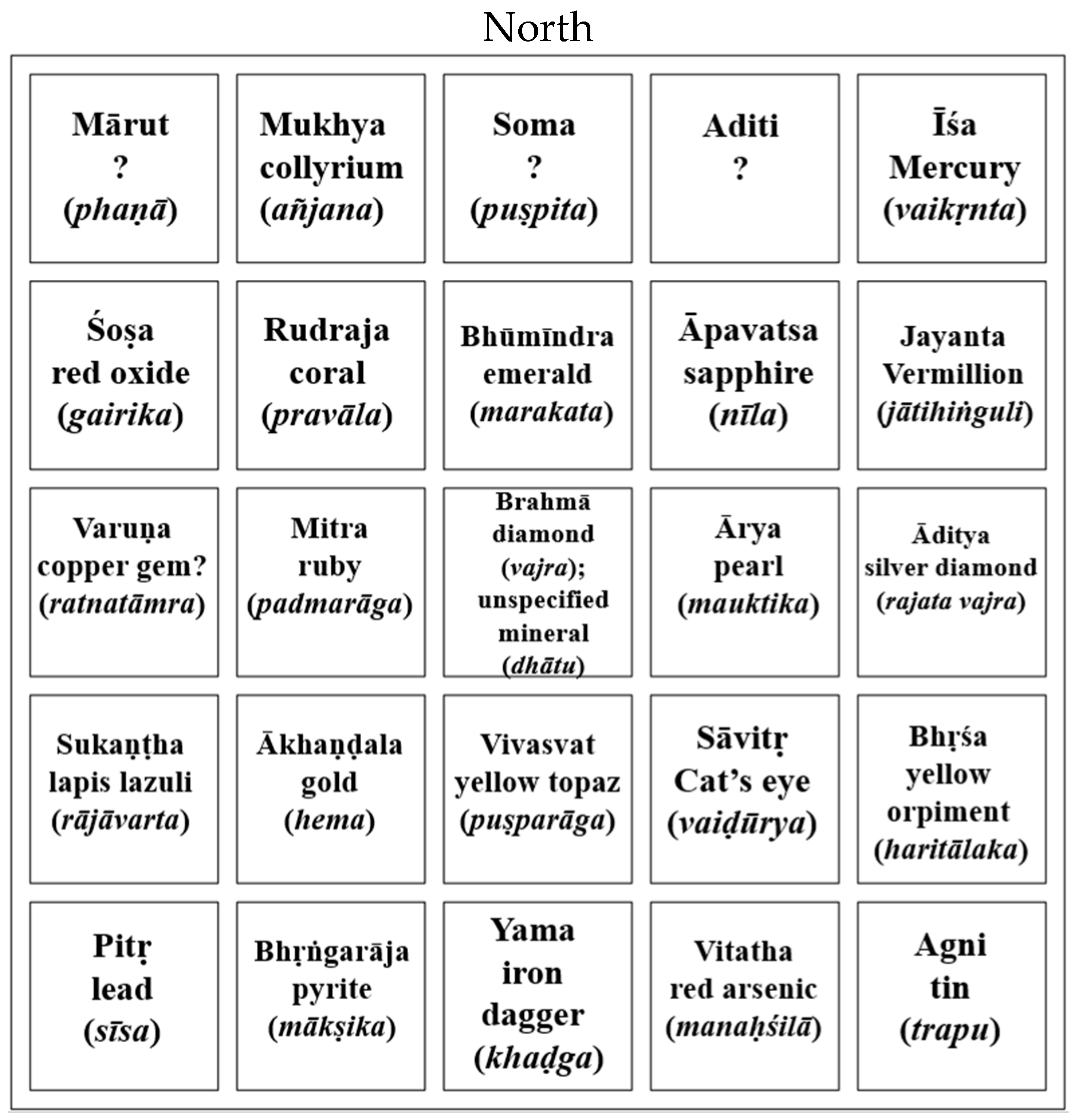
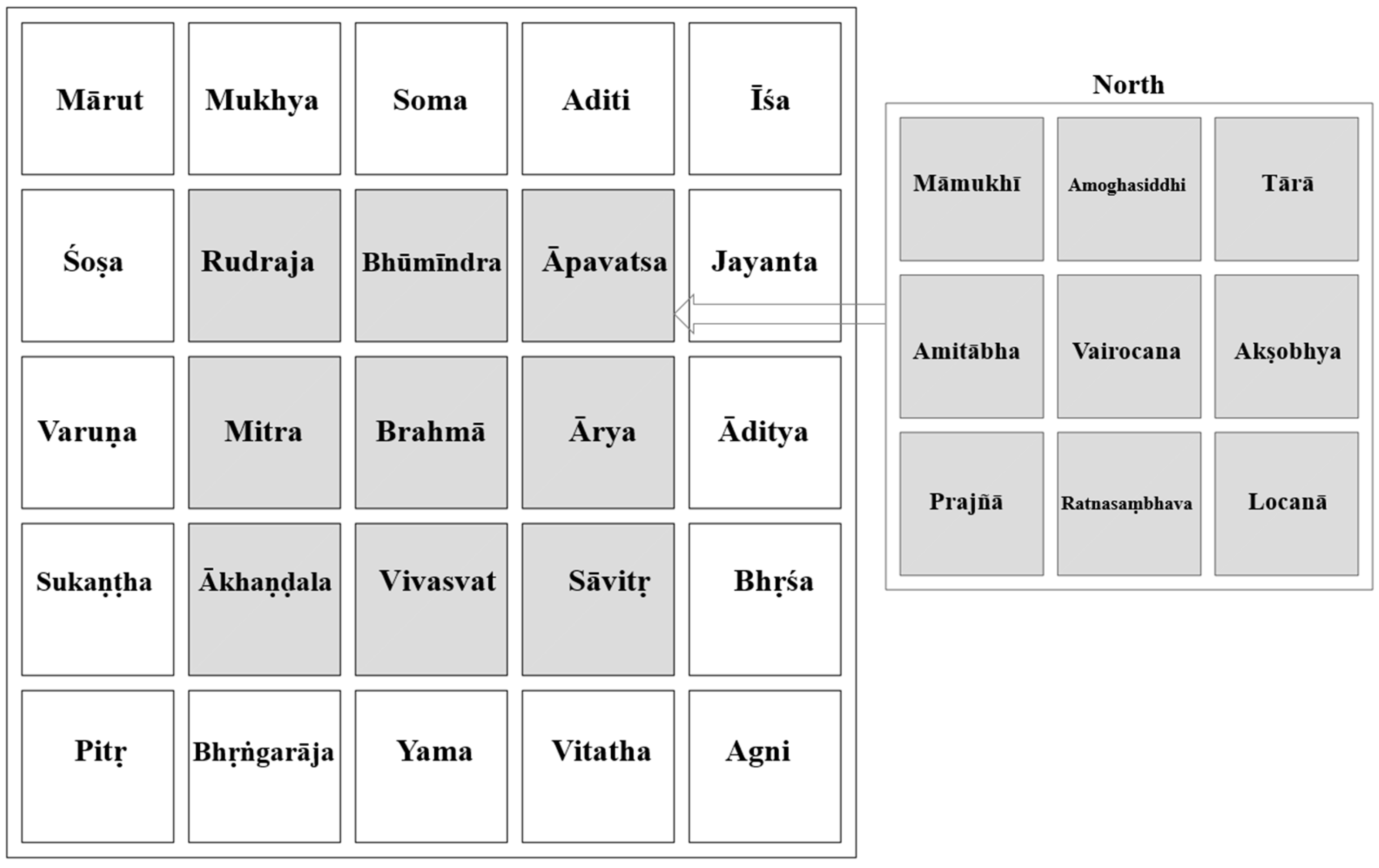

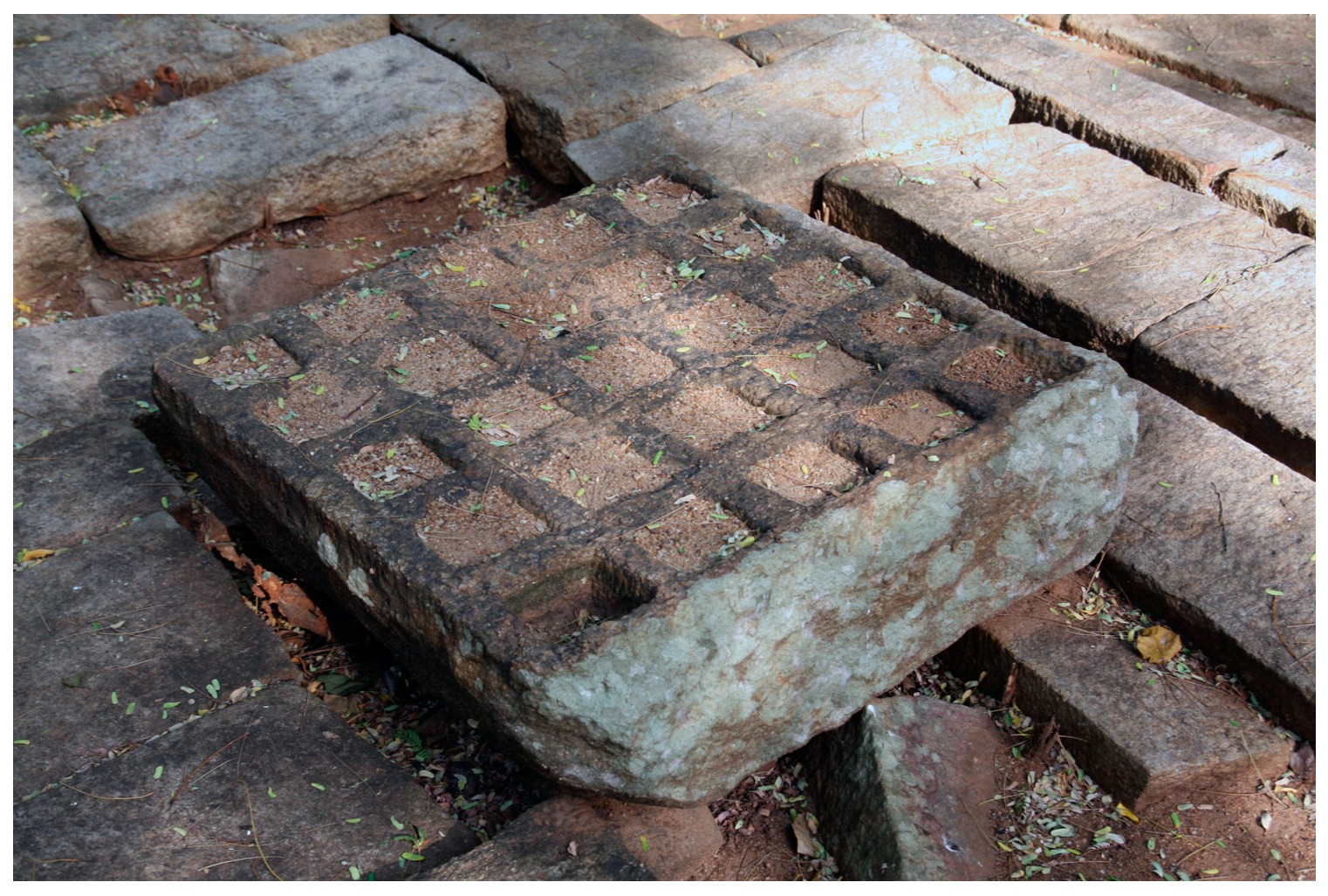

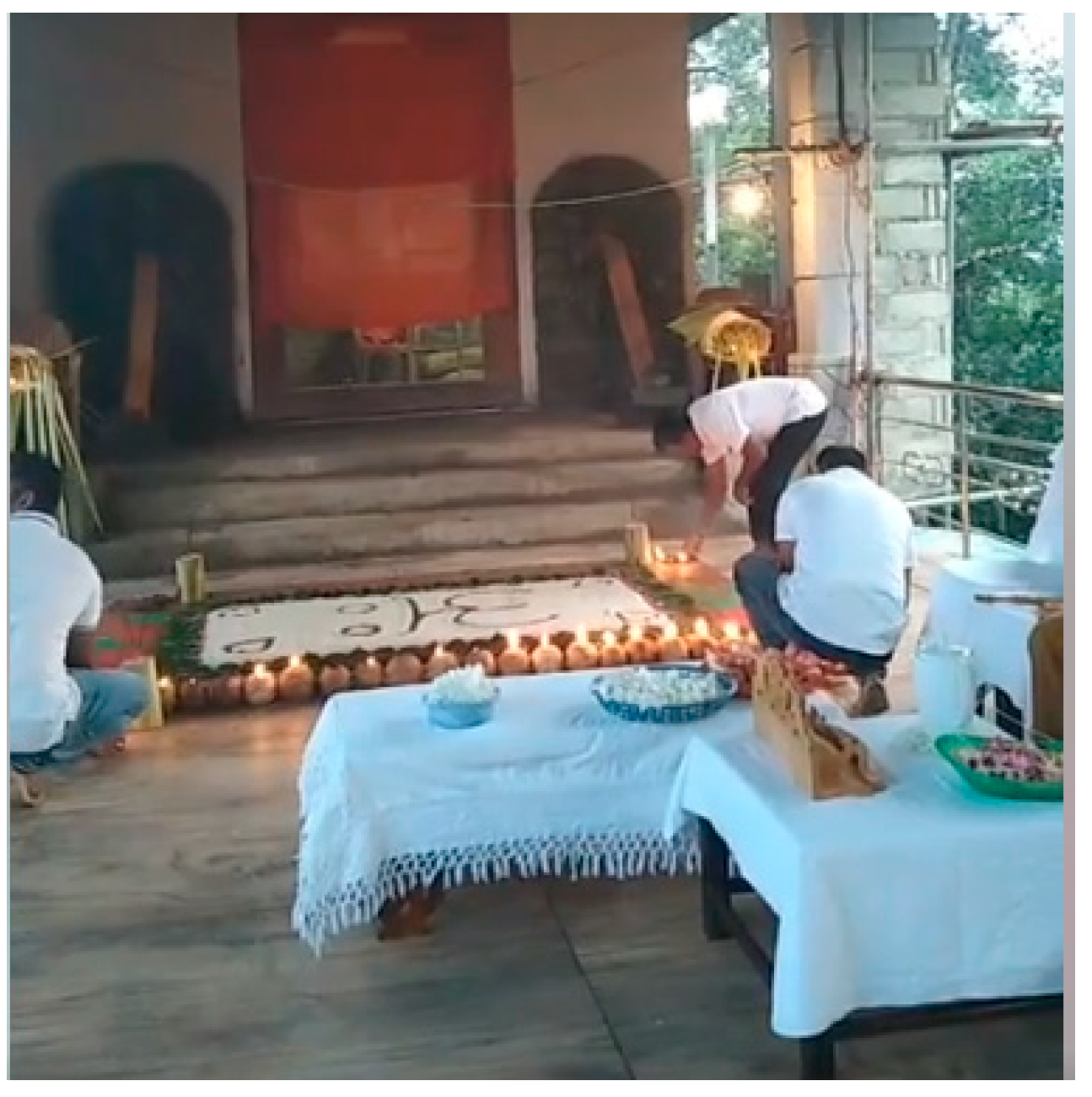
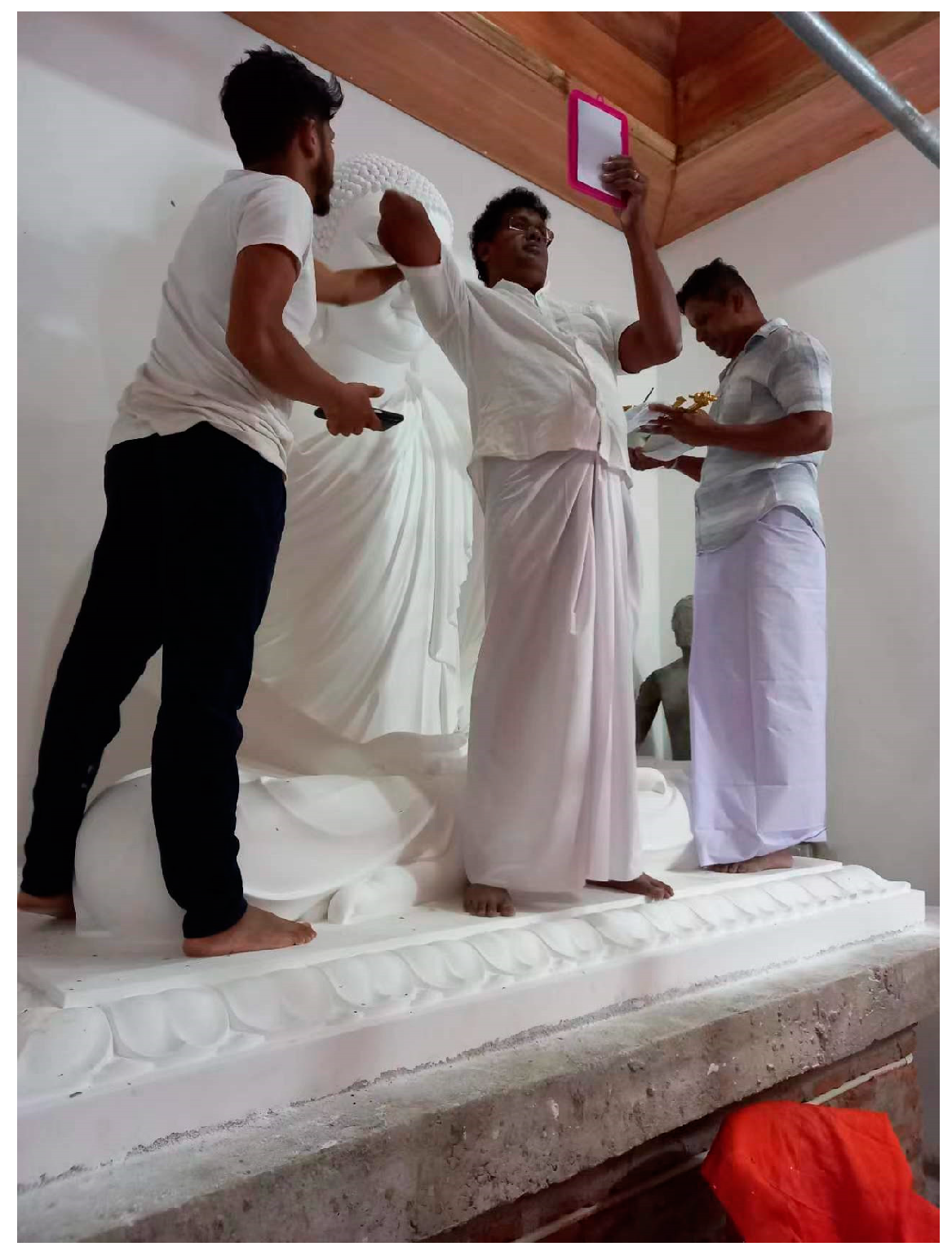

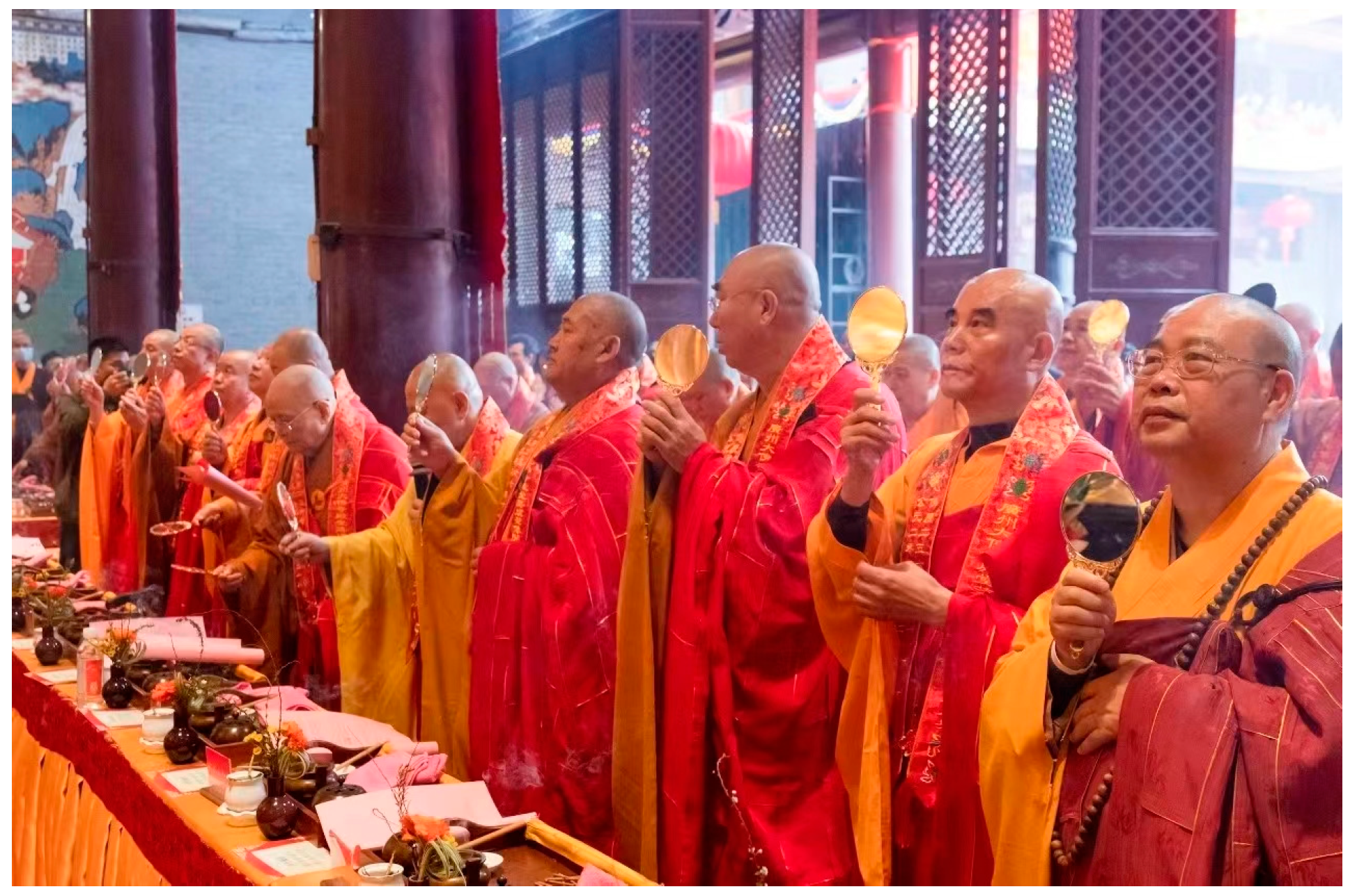
| Citrakarmaśāstra | Kāśyapaśilpa |
|---|---|
| 4. Types of Trees (vṛkṣasaṃgrahaṇa) | 79. Types of Trees (vṛkṣasaṃgrahaṇa) |
| 7. Characteristics of the Armature (śūlalakṣaṇa) | 80. Characteristics of the Armature (śūlalakṣaṇa) |
| 8. Installation of the Gem Deposit (ratnanyāsavidhāna) | 81. Characteristics of the Śūlapāṇi (śūlapāṇilakṣaṇa) 1 |
| 9. Making of the Eight-fold Paste (aṣṭabandhavidhāna) | 82. Binding of the Ligatures (rajjubandhalakṣaṇa) |
| 10. Placing of the Ligatures (rajjukarmavidhāna) | |
| 11. Characteristics of the Clay (mṛttikālakṣaṇa) | 83. Characteristics of the Clay (mṛtsakāralakṣaṇa) |
| 12. Making of the Limestone Paste (kaṭaśarkarāvidhāna) | 84. Making of the Limestone Paste (kalkasaṃskāralakṣaṇa) |
| 16. Preparation of the Pigments (varṇalakṣaṇavidhāna) | 85. Preparation of the Pigments (varṇasaṃskāralakṣaṇa) |
| 86. Plastering of the Pigments (varṇalepana) |
| Chapter 8 in the Citrakarmaśāstra | Chapter 36 in the Kāśyapaśilpa (Ślączka 2007, p. 88f) | Chapter 17 in the Ajitāgama (Bhatt 1964, pp. 122–30) |
|---|---|---|
| Three kinds of receptacles, made of gold, silver, and copper, are desired. (svarṇaṃ rūpyamayaṃ tāmraṃ trividhaṃ bhājanamiṣyate.) | A deposit casket is to be made of gold, silver, or copper. The casket made of gold is considered excellent, the one made of silver is considered average, and the one made of copper is considered poor. (sauvarṇaṃ rūpyamayaṃ tāmraṃ śreṣṭhamadhyādhamaṃ kramāt.) Make twenty-five compartments inside the casket. (pañcaviṃśatikoṣṭhāni bhājanābhyantare kuru.) One should place the gems, metals, and minerals inside the casket. (ratnalohāni dhātūni phelāyābhyantare nyaset.) | [A deposit casket is made of] gold, silver, copper, or brass. (sauvarṇaṃ rājataṃ vāpi tāmrajaṃ kāṃsyajaṃ tu vā.) [The deposit casket possesses] twenty-five compartments or nine compartments. (pañcaviṃśatibhiḥ koṣṭhair navabhir vā samanvitam.) |
| Pearl should be placed in the āryāṃśa…The nine gems deposited in the caṇḍita 1 plan of the pīṭha is the inferior deposit. [These are the three types of deposit, namely], superior, average, and inferior. (āryāṃśe mauktika[n] nyāsya[ṃ]…pīṭhañcaṇḍitavinyāsa[n] navaratnapratiṣṭhitam, evamadhamavinyāsa[m] uttamamadhyamādhamā[ḥ].) | One should place a ruby in the kūṭa [compartment] while uttering the kūṭākṣara. In the “Ananta”, one should place a diamond; in the “Sūkṣma”, a pearl. In “Śivottama”, there should be a sapphire; in “Ekanetraka”, a crystal; in “Ekarudra”, there should be a conch; in “Trimūrti”, a topaz…(māṇikyaṃ vinyaset kūṭe kūṭākṣaram udāran, anante vinyased vajraṃ sūkṣme mauktikaṃ nyaset. śivottamendranīlaṃ syāt sphatikaṃ tv ekanetrake, ekerudre tu śaṅkhaṃ syāt trimūrtau puṣparāgakam…) | In all these compartments, one should place the kūṭākṣara in the center. In the surrounding eight [compartments], one should place syllables beginning with ya and ending with ha. Outside of that, one should arrange the sixteen vowels from the easterly direction. (teṣu koṣṭheṣu sarveṣu madhye kūṭākṣaraṃ nyaset. yakārādihakārāntaṃ parito ‘ṣṭasu vinyaset. tadbāhye pūrvataścāpi svarānṣoḍaśa vinyaset.) In the center, one should place a golden serpent-king and a network of letters extending up to weapons such as thunderbolts (vajra) and spears (śūla). Among these, in the eastern part, one should place a ruby; in the northern part, a sapphire (indranīla); in the western part, a sphaṭika (crystal); and in the southern part, a diamond (vajra), which resides in the realm of the moon. In the northeastern part, a pearl… (madhye phaṇīndraṃ haimaṃ tu vinyasedatha dikṣu ca. vajrādiśūlaparyantamattrajālaṃ ca vinyaset. māṇikyamatha tanmadhye pūrve marakataṃ nyaset. indranīlaṃ tu yāmye tu sphaṭikaṃ paścime tathā. vajraṃ tu saumyadigbhāge vaiḍūryaṃ vahnigocare…) |
| He should place the copper receptacle covered with a new cloth on the grain. After the consecration of the aṅga (?), a pavilion (maṇḍapa) or a hall (sabhā) or a light building (prapā) 2 [should be established] in front of the image house ……or behind it. It (i.e., a pavilion or a hall or a prapā) is decorated with a base (adhiṣṭhāna) or a base (ādyaṅga) 3 occupying three out of twelve parts [of the height], endowed with four doorways adorned with four arches, provided with canopies, flags and banners, and beautified with wreaths of darbha grass. (navavastrāvṛtantāmrabhājanaṃ dhānye vinyaset, aṅgādhivāsanampaścād maṇḍapaṃ vā [sa]bhā prapā. bimbālayād mukhe vātha [+ + +] pṛṣṭhabhāk, tribhaktidvādaśabhāgam adhiṣṭhānādyaṅgabhūṣaṇam. catu[r]dvāramamāyuktaṃ catustoraṇabhūṣitam, vitānaketupatākādarbhamālāsuśobhanam.) | To the north of the temple or in front of it one should build a very beautiful pavilion, measuring five, six, or seven hastas and having sixteen pillars. One should cover [the pavilion] from above with a canopy, [the pavilion which is endowed] with ”waves” and pillar wrappings, and it should be equipped with doors and arches and decorated with darbha grass and garlands. (prāsādasyottare vāgre pañcaṣaṭsaptahastakām, ṣoḍaśastaṃbhasaṃyuktāṃ prapāṃ kr̥tvātisundarām. vitānenodhvamācchādya taraṃgaiḥ staṃbhaveṣṭanaiḥ, dvāratoraṇasaṃyuktāṃ darbhamālādibhūṣitām.) In the middle [of the pavilion], one should prepare a platform measuring one-third of the pavilion, with a height measuring one hasta or one tāla. (maṇḍapasya tribhāgaikaṃ madhye vediṃ prakalpayet, hastamātrasamutsedhāṃ tālamātrām athāpi vā.) | In front of the temple (prāsāda), on both sides, construct a pavilion, measuring five, six or seven hastas, with smaller and smaller [pillars] (?). In its center, construct an elevated platform adorned with gems. Prepare four pits in the four directions. One [of the pits] should be made eastward according to the size of a gem. Or, alternatively, one should prepare bare ground everywhere for the purpose of fire oblation. The pavilion should be smeared with cow dung, and the platform and pits should be adorned with darbha grass and other decorations as appropriate. After declaring an auspicious day, one should prepare the platform on the pavilion, with purified rice grains spread as required. After painting there a lotus with eight petals and a pericarp, one should place the deposit container in the center with the hṛdaya mantra. (prāsādāgre ‘thavā pārśvadvayoḥ kṛtvā tu maṇḍapam. pañcaṣaṭsaptahastaistu kanyasādikrameṇa (?) tu. tanmadhye vedikāṃ kṛtvā ratnimātrasamucchritām. caturdikṣu ca kuṇḍāni caturaśrāṇi kalpayet. ekaṃ vā prāci kartavyaṃ ratnimātrapramāṇataḥ. sthaṇḍilaṃ vāpi sarvatra homārthaṃ parikalpayet. gomayenopalipyātha maṇḍapaṃ vedikuṇḍayuk. darbhamālādibhiḥ sarvairalaṃkṛtya yathāvidhi. puṇyāhaṃ vācāyitvātha kalpayedvedikopari. śālibhirvimalaistatra sthaṇḍilaṃ tu yathāvidhi. tatra padmaṃ samālikhya sāṣṭapatraṃ sakarṇikam. tanmadhye garbhaphelāṃ ca vinyaseddhṛdayena tu.) |
| The placing of the pitchers is carried out at the eastern part of the shed. [There shall be] twenty-five or nine pitchers, each full of water and tied with thread. It is known that the width of the grain [heap] is two hastas, and the height is half a hasta. One should draw the pīṭha or the upapīṭha diagram on the grain…[Next,] one should place the figures of the five Buddhas in it. The deities, starting with Isa and ending with Aditi, are placed [in the appropriate padas]. After worshipping with a pleasant mind…… [The artisan] shall wrap each [pitcher] with a white cloth in due order. (maṇḍapāt pūrvabhāge tu kalaśasthāpanaṃ kṛtam, pañcaviṃśan[na]vo vāpi kalaśāḥ sūtraveṣṭitāḥ. dvihastandhānyavistāraṃ hastārdhoccaṃ samāśrutam (? samāśritam), dhānyopari likhet pīṭhamupapīṭhaṃ vā kalpitam… pañcabuddhātmakaṃ rūpaṃ tadrūpaṃ tasya vinyaset, īśānādyadityantañca tattattasya pratiṣṭhitam. [+ + +] namaskṛtya prasannadhīḥ, ekaikaṃ [śveta]vastreṇa veṣṭayet kalaśān kramāt.) Inside the Brahmā pitcher, the nine kinds of gem are deposited. [The artisan] shall propitiate [the pitchers] with incense, perfume and burning lamps in due order… After offering the vāstudevatās their oblations, which include ghee thrown into the fire, one should offer food in the form of milk rice and ghee to the five deities identified with the brahman. (brahmakumbhasya madhye tu navaratnampratiṣṭhitam, sadhūpagandhapuṣpaiśca dīpaiḥ santoṣayet kramāt…vāstudevabalindatvā ghṛtānnampāvakādinām, pañcabrahmamaya{n}devān pāyasānnaṃ ghṛtaṃ dadyāt.) | Having worshipped the gods of the directions with incense, flowers, and so on while reciting to each god his own mantra, having sprinkled the casket with the products of the cow, one should bathe it with fragrant waters. Having tied the kautuka [around the casket] by means of a thread, one should wrap [the casket] in a new cloth. [The casket] should be placed on the ceremonial ground while pronouncing the kūṭākṣara. (gandhapuṣpādibhiḥ pūjya digdevān svasvamantrataḥ gavyābhiṣicya phelāṃ tu snāpayedgandhatoyakaiḥ. tantunā kautukaṃ baddhvā navavastreṇa veṣṭayet, sthaṇḍile tu nidhātavyaṃ kūṭākṣaramudāharan.) Having placed the eight jars all around, tied with cords, provided with covers, [decorated] with bundles of kuśa grass, enveloped with cloth, filled with fragrant water, having placed the jars dedicated to the Vidyeśvaras, having worshipped them with their own mantras, having performed the five sacraments for the kuṇḍas, one should begin the fire oblation. (parito ’ṣṭau ghaṭānnyasya sasūtrān sapidhānakān, sakūrcān vastrasaṃchannān gandhāmbuparipūritān. vidyeśādhipakuṃbhāṃstān sthāpyābhyarcya svamantrataḥ, kuṇḍānāṃ pañcasaṃskāraṃ kr̥tvā homaṃ samārabhet.) | Then one should perform the fire oblation and then prepare the fire oblation to the revered deity with a root mantra. Following a specific order, [one should offer] various ingredients one by one, including ghee, rice, parched grains, sesame seeds, mustard seeds, barley, and others. One who is proficient in the mantra should offer either one hundred and fifty oblations or half of that amount. Upon completing [the offering of] all the ingredients, one should sprinkle water with the same mantra. Subsequently, one should offer only the deposit container to the Phaṇīndra. One should offer the oblation enriched with all the spices, while [reciting] the pūrṇamūla [mantra]. (tato homaṃ prakurvīta tataḥ prasthāpitasya tu. devasya mūlamantreṇa samiddhomaṃ prakalpayet. ājyaṃ caruṃ tathā lājaṃ tilaṃ sarṣapameva ca. yavāṃśca tattadaṅgaiśca hṛdayādyairanukramāt. homayecchatamardhaṃ vā tadardhaṃ vāpi mantravit. sarvadravyāvasāne tu tattanmantreṇa saṃspṛśet. garbhabhāṇḍaṃ tataścaiva phaṇīndrāya nivedayet. haviḥ sarvopadaṃśāḍhyaṃ pūrṇāṃ mūlena 4 homayet.) |
| Citrakarmaśāstra | Vimānārcanākalpa 1 | Kāśyapaśilpa | Śilparatna |
|---|---|---|---|
| making of the eight-fold paste (aṣṭabandhavidhāna) | eight-fold paste (aṣṭabandhaḥ) | characteristics of ligatures (rajjubandhalakṣaṇa) | characteristics of ligatures (rajjubandhalakṣaṇa) |
| placing of ligatures (rajjukarmavidhāna) | encircling [the armature] with ligatures (rajjuveṣṭanam) | ||
| characteristics of the clay (mṛttikālakṣaṇa) | employing the clay (mṛtsaṅgrahaṇaṃ) | characteristics of the clay (mṛtsakāralakṣaṇa) | rules for smearing the clay (mṛllepanavidhi) |
| making of the limestone paste (kaṭaśarkaravidhāna) | employing the limestone paste (śarkarāgrahaṇam) | preparation and characteristics of the limestone paste (kalkasaṃskāralakṣaṇa) | |
| preparation of the pigments (varṇalakṣaṇavidhāna) | preparation of the pigments (varṇasaṃskāraḥ) | preparation of the pigments (varṇasaṃskāralakṣaṇa) | |
| painting of the pigments (varṇalepana) |
| Mayamata 1 | Mānasāra 2 | Vimānārcanākalpa 3 | Vaikhānasāgama 4 | Citrakarmaśāstra |
|---|---|---|---|---|
| Sowing seeds (aṅkurārpaṇa) | Sowing seeds (aṅkurārpaṇa) | Sowing seeds (aṅkurārpaṇa) | Sowing seeds (aṅkurārpaṇa) | |
| The description of flagstaffs and banners that should be placed in the cardinal and intermediate directions surrounding the image-hall | ||||
| The establishment of a pavilion (maṇḍapa) and an altar (vedi) for the sacrifice in connection with the opening of eyes | The establishment of a pavilion (maṇḍapa) and an altar (vedi) for the sacrifice in connection with the opening of eyes | Drawing a pīṭha on the ground and installing the gem deposit (ratnanyāsa) | Drawing a pīṭha on the ground and installing the gem deposit (ratnanyāsa) | The establishment of the sacrificial altar |
| The drawing of a upapīṭha or pīṭha and placing of pots (kalaśādhivāsana) | The drawing of a upapīṭha or pīṭha and placing of pots (kalaśādhivāsana) as well as the fire oblation (homa) | Performing the fire oblation to vāstudevas (vāstuhoma) | Performing the fire oblation to vāstudevas | The placing of pots (kalaśādhivāsana) |
| Worship of the image and painting of eyes | Worship of the image and painting of eyes | Opening the eyes with a golden needle | Opening the eyes with a golden needle | Opening the eyes with a golden needle and with the help of a mirror |
| Burnt-offerings to avert evil (homaśānti) | ||||
| The placing of pots and worship of the image | The placing of pots and worship of the image | The placing of pots and worship of the image | The placing of pots and worship of the image |
| Manuscript | Edition 1 |
|---|---|
| gandhārīhastajivhāpūṣāsvinīralamprataḥ kuhūcatuhāmadhyamanīsaptadhātukproktampurvotrayodaśādhikā evampradhānanāḍīcaśeṣāṃrajjuprabandhanam tatmaddhasandhaurūpasyājivhāsthānavidhīyate | gāndhārī hastijihvā [ca] pūṣāsvinīr alambuṣā. kuhū ca śaṅkhinī saptadhā {tuk}proktās {pūrvo}trayī nāḍikāḥ. evaṃ pradhānanāḍyaśca śeṣaṃ rajjuprabandhanam. tanmadhyasandhau rūpasya jihvāsthāna[ṃ] vidhīyate. |
Disclaimer/Publisher’s Note: The statements, opinions and data contained in all publications are solely those of the individual author(s) and contributor(s) and not of MDPI and/or the editor(s). MDPI and/or the editor(s) disclaim responsibility for any injury to people or property resulting from any ideas, methods, instructions or products referred to in the content. |
© 2024 by the author. Licensee MDPI, Basel, Switzerland. This article is an open access article distributed under the terms and conditions of the Creative Commons Attribution (CC BY) license (https://creativecommons.org/licenses/by/4.0/).
Share and Cite
Wu, W. A Patchwork of Hindu Ritual Practices and Technique Performances? A Re-Examination of the Citrakarmaśāstra, a Vajrayānic Sanskrit Śilpa Text Discovered in Sri Lanka. Religions 2024, 15, 146. https://doi.org/10.3390/rel15020146
Wu W. A Patchwork of Hindu Ritual Practices and Technique Performances? A Re-Examination of the Citrakarmaśāstra, a Vajrayānic Sanskrit Śilpa Text Discovered in Sri Lanka. Religions. 2024; 15(2):146. https://doi.org/10.3390/rel15020146
Chicago/Turabian StyleWu, Weilin. 2024. "A Patchwork of Hindu Ritual Practices and Technique Performances? A Re-Examination of the Citrakarmaśāstra, a Vajrayānic Sanskrit Śilpa Text Discovered in Sri Lanka" Religions 15, no. 2: 146. https://doi.org/10.3390/rel15020146
APA StyleWu, W. (2024). A Patchwork of Hindu Ritual Practices and Technique Performances? A Re-Examination of the Citrakarmaśāstra, a Vajrayānic Sanskrit Śilpa Text Discovered in Sri Lanka. Religions, 15(2), 146. https://doi.org/10.3390/rel15020146






